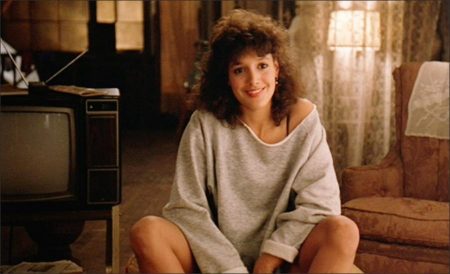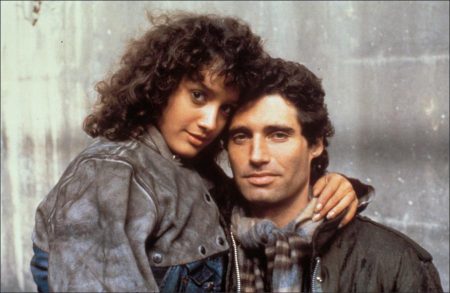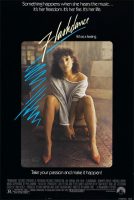Flashdance movie storyline. The plot is every young woman’s daydream come true. Jennifer Beals holds down a macho job as a welder by day, but performs erotic dance numbers in a club at night. It’s not a strip club, so her morality remains intact. She dates her wealthy boss (Michael Nouri) and practices hard for the day she can audition for the upscale, local dance school, even though she has no formal training.
That Oscar-winning title song buzzes in your ears long after the movie has stopped. The attraction here is youthful spirit and a pulsating score, because the weak story is merely a conduit for the song-and-dance numbers.
It is malarkey, of course, unless you view this as total romantic fantasy. It works because you are carried along by the sheer force of the energetic, boisterous, MTV-style imagery by director Adrian Lyne. Beals is a plus as the stubborn, pouty, somewhat eccentric young woman made all the more interesting for her driving ambition. In the end, she is aided by her Prince Charming, who arrives bearing favors. Mind you, this is not the same as a rescue, as Beals is one rather tough damsel who does just fine on her own.
Flashdance is a 1983 American romantic drama film directed by Adrian Lyne. It was the first collaboration of producers Don Simpson and Jerry Bruckheimer and the presentation of some sequences in the style of music videos was an influence on other 1980s films, including Top Gun (1986), Simpson and Bruckheimer’s most famous production.
Flashdance opened to negative reviews by professional critics, but was a surprise box office success, becoming the third highest-grossing film of 1983 in the United States. It had a worldwide box-office gross of more than $100 million. Its soundtrack spawned several hit songs, among them “Maniac” performed by Michael Sembello and the Academy Award–winning “Flashdance… What a Feeling”, performed by Irene Cara, which was written for the film.

Music for Flashdance
“Flashdance… What a Feeling” was performed by Irene Cara, who also sang the title song for the similar 1980 film Fame. The music for “Flashdance… What a Feeling” was composed by Giorgio Moroder, and the lyrics were written by Cara and Keith Forsey. The song won an Academy Award for Best Original Song, as well as a Golden Globe and numerous other awards. It also reached number one on the Billboard Hot 100 in May 1983.
Despite the song’s title, the word “Flashdance” itself is not heard in the lyrics. The song is used in the opening title sequence of the film, and is the music Alex uses in her dance audition routine at the end of the film.
Another song used in the film, “Maniac”, was also nominated for an Academy Award. It was written by Michael Sembello and Dennis Matkosky. A popular urban legend holds that the song was originally written for the 1980 horror film Maniac, and that lyrics about a killer on the loose were rewritten so the song could be used in Flashdance.
The legend is discredited in the special features of the film’s DVD release, which reveal that the song was written for the film, although only two complete lyrics (“Just a steel town girl on a Saturday night” and “She’s a maniac”) were available when filming commenced. Like the title song, it reached number one on the Billboard Hot 100 in September 1983.
Other songs in the film include “Lady, Lady, Lady”, performed by Joe Esposito, “Gloria” and “Imagination” performed by Laura Branigan, and “I’ll Be Here Where the Heart Is”, performed by Kim Carnes.
The soundtrack album of Flashdance sold 700,000 copies during its first two weeks on sale and has gone on to sell over 6,000,000 copies in the US alone. In 1984, the album won the Grammy Award for Best Album of Original Score Written for a Motion Picture or a Television Special.
Flashdance (1983)
Directed by: Adrian Lyne
Starring: Jennifer Beals, Michael Nouri, Lilia Skala, Sunny Johnson, Kyle T. Heffner, Lee Ving, Ron Karabatsos, Belinda Bauer, Micole Mercurio, Lucy Lee Flippin, Cynthia Rhodes
Screenplay by: Thomas Hedley Jr., Joe Eszterhas
Production Design by: Charles Rosen
Cinematography by: Donald Peterman
Film Editing by: Walt Mulconery, Bud S. Smith
Costume Design by: Michael Kaplan
Set Decoration by: Marvin March
Music by: Giorgio Moroder
Distributed by: Paramount Pictures
Release Date: April 15, 1983
Views: 280


